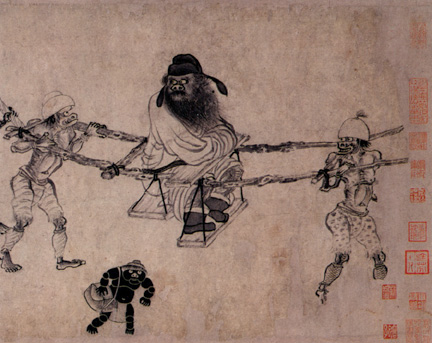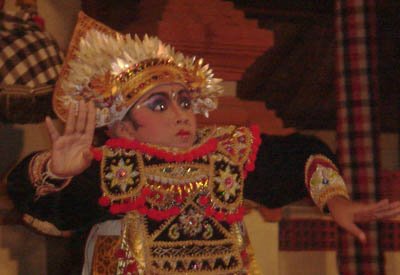 A TRADITIONAL CHINESE ORIENTATION TOWARD KNOWLEDGE
A TRADITIONAL CHINESE ORIENTATION TOWARD KNOWLEDGE.
Sometimes when a Chinese teacher is trying to explain a term they will instead explain a term which is a homonym. Because there are so many words in Chinese which sound alike, simular sounding words can, over hundereds of years, take on parallel or related meanings and so in this chapter, instead of explaining
jing, the solid, more structural or dense aspect of Qi, I will instead explain
jing, a classic.
The term jing (ching) is usually translated: Classic. "...(It) is the underlying structure, both in the human body, such as the meridians of acupuncture, and in the body of knowledge of a civilization. This is the general name given to all the "master texts," such as the Tao-te ching, ... [or the I Ching (Yijing)]. It can be used to describe books that are not philosophical (e.g. Nei Ching, "The internal Classic," the master text of Chinese medicine) or even Chinese (e.g. Shen Ching, "The Holy Classic," the Bible). The literal meaning of this character is "warpage" (the threads stretched out lengthwise in a loom that give structure to the fabric that is woven),...." (Cyrille Javary , Understanding the I Ching, p. xii.)
, Understanding the I Ching, p. xii.)

What is the appropriate attitude with which to approach a traditional Chinese subject? How do we go about the process of unfolding the subject of the
Internal Arts keeping in mind their traditional context?
The classical version of traditional literature uses very dense concentrated metaphorical and symbolic language to describe a topic. Often it is a consolidation of many earlier texts which have made mention of the topic at hand. These concentrated classics are committed to memory. Understanding is expected to come over an extended period of time, with experience. In some ways this is a good summary of what a Taijiquan
form or a qigng movement series is in itself.
Out of this literary tradition grew a tradition of commentary and explanation, probably the consolidation of many generation of practitioners notes from the margins of their copies of the original classic. A popular way to begin a study of a classic, or jing, is for the teacher to take only the first character of the text and from just that character, reconstruct the essence, or "view" of the entire text. Commentaries which really pull apart or expand the meanings of a classic text tend to read like overwhelming layers of wafting clouds passing through the reader; too much to actually grasp, likely to invoke sleep, an inventory of embedded meanings meant to have an influence over time.
Studying Internal arts is something like memorizing a classic (jing). A classic, like a an Internal arts
routine, embodies conservation, efficiency and the unfolding of the totality of previous experience in a concentrated form. In both cases the relationship of student to practice and student to teacher is the processes of unfolding and revealing the
text or
form and then re-embodying it in its concentrated efficiency.

I'm calling it concentrated efficiency because that is what it seems like from the outside looking in, but to actually embody either a classic text or a
internal arts form feels plain, bland and simple. A traditional Chinese scholar can seamlessly weave a classic, they have memorized, in and out of their speech in such a way that someone who is unfamiliar with the classic won't notice. In fact, scholars who have memorized and embodied many classic texts can play games together where they seamlessly string together classic quotes and yet speak to each other from the heart about things which are important to them. In fact, China has a tradition of scholars with huge appetites for study who can actually quote continuously with genuineness and sincerity. To truly embody an
internal practice is the same. On the outside one appears to be doing regular everyday movement, but inside the
form (or we could say
qigong) is happening all the time, it becomes second nature.
The practice of Push-hand is analogous to the senario where two scholars are spontaneously exchanging quotes from classic texts while discussing a third topic.
 Today is Yom Kippur.
Today is Yom Kippur.
 Sun Tzu,
Sun Tzu,  The T'ai Chi Boxing
The T'ai Chi Boxing 
 subject,
subject,  The third century B.C.E. text known as the
The third century B.C.E. text known as the 

 When I saw a book titled,
When I saw a book titled,  Most people, including me, first learned internal martial arts and qigong with out a Daoist inspired view.
Most people, including me, first learned internal martial arts and qigong with out a Daoist inspired view. traditional Chinese subject? How do we go about the process of unfolding the subject keeping in mind its traditional context?
traditional Chinese subject? How do we go about the process of unfolding the subject keeping in mind its traditional context? A TRADITIONAL CHINESE ORIENTATION TOWARD KNOWLEDGE.
A TRADITIONAL CHINESE ORIENTATION TOWARD KNOWLEDGE. What is the appropriate attitude with which to approach a traditional Chinese subject? How do we go about the process of unfolding the subject of the Internal Arts keeping in mind their traditional context?
What is the appropriate attitude with which to approach a traditional Chinese subject? How do we go about the process of unfolding the subject of the Internal Arts keeping in mind their traditional context? I'm calling it concentrated efficiency because that is what it seems like from the outside looking in, but to actually embody either a classic text or a internal arts form feels plain, bland and simple. A traditional Chinese scholar can seamlessly weave a classic, they have memorized, in and out of their speech in such a way that someone who is unfamiliar with the classic won't notice. In fact, scholars who have memorized and embodied many classic texts can play games together where they seamlessly string together classic quotes and yet speak to each other from the heart about things which are important to them. In fact, China has a tradition of scholars with huge appetites for study who can actually quote continuously with genuineness and sincerity. To truly embody an internal practice is the same. On the outside one appears to be doing regular everyday movement, but inside the form (or we could say qigong) is happening all the time, it becomes second nature.
I'm calling it concentrated efficiency because that is what it seems like from the outside looking in, but to actually embody either a classic text or a internal arts form feels plain, bland and simple. A traditional Chinese scholar can seamlessly weave a classic, they have memorized, in and out of their speech in such a way that someone who is unfamiliar with the classic won't notice. In fact, scholars who have memorized and embodied many classic texts can play games together where they seamlessly string together classic quotes and yet speak to each other from the heart about things which are important to them. In fact, China has a tradition of scholars with huge appetites for study who can actually quote continuously with genuineness and sincerity. To truly embody an internal practice is the same. On the outside one appears to be doing regular everyday movement, but inside the form (or we could say qigong) is happening all the time, it becomes second nature. When two different cultures meet, dance is the first art across the border. Music is very close behind. Interaction with another culture has great potential to create change; most societies fear change. This is why societies so often ban or at least try to control dance.
When two different cultures meet, dance is the first art across the border. Music is very close behind. Interaction with another culture has great potential to create change; most societies fear change. This is why societies so often ban or at least try to control dance.
 Understanding the cultural and historic significance of hair in China will really help give meaning to the underlying metaphors of song.
Understanding the cultural and historic significance of hair in China will really help give meaning to the underlying metaphors of song. Han (ethnic Chinese) males were forced to wear their hair in a cue as a form of national humiliation. If you cut your cue the penalty was death. Historically the cue was used at night by the Jurchen people to tie their slaves to a post. So the term song could easily be understood as harboring some revolutionary bravado.
Han (ethnic Chinese) males were forced to wear their hair in a cue as a form of national humiliation. If you cut your cue the penalty was death. Historically the cue was used at night by the Jurchen people to tie their slaves to a post. So the term song could easily be understood as harboring some revolutionary bravado. Gods also have hair styles. Zhenwu, or Ziwei, is the Chinese god of fate and the central deity of the Chinese pantheon. He is the North Star, the point on the top of your head, and the perfected warrior. He represents the physicality of fearlessness, the perfect mix of pure discipline and extraordinary spontaneity that is the basis for Daoist meditation. In his iconography his hair is song, part of it is tied back in a loose braid with silk and chain to protect his neck from sharp blades, the rest is long and hanging loosely about his shoulders. His hair is a throwback (I couldn't resist) to ancient shaman-warriors who showed their utter lack of concern for status by letting their hair go wild.
Gods also have hair styles. Zhenwu, or Ziwei, is the Chinese god of fate and the central deity of the Chinese pantheon. He is the North Star, the point on the top of your head, and the perfected warrior. He represents the physicality of fearlessness, the perfect mix of pure discipline and extraordinary spontaneity that is the basis for Daoist meditation. In his iconography his hair is song, part of it is tied back in a loose braid with silk and chain to protect his neck from sharp blades, the rest is long and hanging loosely about his shoulders. His hair is a throwback (I couldn't resist) to ancient shaman-warriors who showed their utter lack of concern for status by letting their hair go wild.